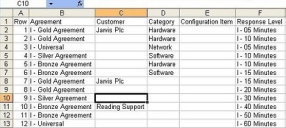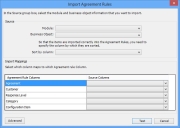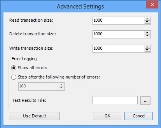Importing and exporting agreement rules
You can, if required, create or modify your agreement rules using a spreadsheet and then import the rules into your system. This can be particularly useful if you have a large number of rules to manage.
A convenient method for ensuring the spreadsheet you import from has the correct columns is to create a single rule in the Administration component and then export that rule. You can then add the rest of your rules to the exported spreadsheet.
To export agreement rules:
- In the Administration component, expand the Service Level Management tree.
- Expand the Agreements folder, then expand the required module.
- Expand the relevant business process, for example, Incident.
- Select the Response Agreements folder, then on the Actions list, click Manage Rules.
The Agreement Rules list appears. - On the Actions list, click Export Rules.
The rules are exported and Microsoft Excel opens displaying your agreement rules.
After you have made the required changes in Microsoft Excel, you can import the agreement rules.
Before you import your agreement rules, we strongly recommend that you back up your database.
You must create a connection to the spreadsheet before you can import the agreement rules.
To import agreement rules:
- Using the Data Connection component, create a connection to the Excel spreadsheet, and configure the connection type.
For more information, see Connections.
- In the Administration component, open the relevant Agreement Rules.
- On the Actions list, click Import Rules.
The Import Agreement Rules dialog appears.
- In the Module list, select the name of the connection that you created to the Excel spreadsheet.
- In the Business Object list, select Rules.
- In the Sort by column list, select the column by which you want to sort the agreement rules. Typically this would be Row as you want to import the agreement rules in the correct order.
- In the Import Mappings group box, specify the Source Columns that map to the Agreement Rule Columns.
- Click Advanced.
The Advanced Settings dialog appears.
- Set the Read transaction size, Delete transaction size, and Write transaction size.
In most circumstances you will not need to change these values. These values correspond to the number of rows that are processed at a time. If you make these values smaller, the import will take longer, as the system reorders the records after each transaction completes. If you make the values too large, the system may be unable to process the individual transactions before the system times out. The default values work well for most systems. To reset to the default values, click Use Default.
- In the Error Logging group box, select either Show all errors, or Stop after the following number of errors, then set a number of errors.
When importing from a spreadsheet, it is easy to make a single mistake in the spreadsheet that results in a large number of errors when importing. The Stop after option is useful in this situation. - In the Test Results File field, enter the name of the text file that you want to use to record the error messages.
New error messages are appended to the end of the existing file. - Click Test.
The Agreement Rules are tested to confirm that the mappings are correct.
If errors appear, you need to ensure that the business object that you are trying to import actually exists within your database. If you need to adjust your mappings, click Back and make the required changes.
- When all of your rules reach the status of OK, click Import.
A warning message appears, telling you that all old rules will be deleted. When you import agreement rules, your existing rules are replaced with the rules that you are importing.
Any entries that are marked as errors are not imported. In certain circumstances, for example, the spreadsheet can have empty rows that result in a set of blank entries at the top of the list.
- Click OK.
When the rules have been successfully imported, a message box appears.
When importing updated agreement rules, it appears that more records are imported than are deleted. This is because when the agreement rules are deleted, all of their variation attributes are deleted at the same time. During the import, however, each agreement rule and all of the variation attributes for each agreement rule are imported.
- Click OK.
The Agreement Rules list is updated.